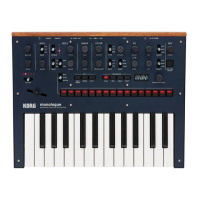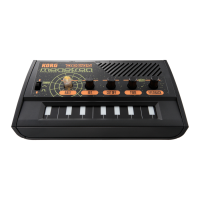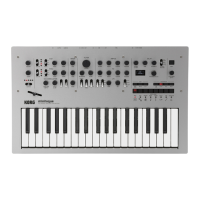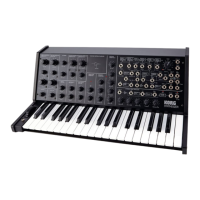Do you have a question about the Korg modvawe and is the answer not in the manual?
Information about the documentation for the modwave synthesizer.
How to navigate the modwave's interface and pages using buttons and displays.
Explanation of the two layers (A and B) and their function in sound editing.
The main page for selecting performances, programs, and viewing Mod Knobs.
Visual display of the Kaoss Physics environment, showing ball position.
Page for selecting programs and volume for each layer.
Setting velocity ranges for layers, including high/low velocity and fade.
Setting note ranges for layers, including high/low notes and fade.
Settings for program volume, transpose, and trigger options.
Setting voice allocation modes (Poly/Mono) and related parameters.
Using multiple stacked voices for a thicker sound.
Settings for layer volume, octave, tune, MIDI channel, and CC reception.
Settings for performance volume, octave, tempo, and transpose.
How to save Performances, Programs, and other data.
Naming saved sounds, including Programs, Sequences, and Presets.
Detailed steps for editing sound names using the interface.
Comparing saved and edited versions of a Performance.
Deleting user-created items from the instrument's database.
Explanation of Wavetable Oscillators and their capabilities.
Selecting the oscillator mode (A, A/B, Sample).
Details on selecting Wavetables A and B for blending.
Options for modifying wavetables, affecting their harmonic content.
Sweeping through waveforms within a selected wavetable.
Balancing the mix between Wavetables A and B.
Controls the crossfading between adjacent waveforms.
Altering wavetables in real-time using various morph types.
Settings for using multisamples as oscillator sources.
Level and pan controls for Oscillator 1.
Level and pan controls for Oscillator 2.
Controls for the sub oscillator or noise generator.
Introduction to motion sequencing features and lane structure.
Overview of motion sequence lanes, steps, and symbols.
Recording sequences of notes into the Pitch lane.
Recording knob movements into Seq Lanes.
Controls for lane playback, looping, and step management.
Viewing and editing individual steps within a lane.
Temporarily looping a single step for auditioning or troubleshooting.
Selecting a motion sequence preset for the program.
Synchronizing motion sequence notes with tempo and other sequences.
Overview and controls for the Master Lane, which restarts other lanes.
Common controls for all lanes except Master (Preset, Loop, Mode).
Setting the probability of a step playing.
Controls step duration and rhythm creation.
Sets the pitch for each step in the sequence.
Constraining pitch output to a specific scale and key.
Creates a contour over the duration of a step, affecting other lanes.
Lanes for generating modulation sources like envelopes and LFOs.
Settings for individual Seq Lane steps, including type and value.
Tools for managing steps and lanes (Cut, Copy, Paste, Clear).
Introduction to Kaoss Physics, its outputs, and MIDI messages.
MIDI messages related to Kaoss Physics operation.
Enabling or disabling the Kaoss Physics model.
Detailed parameters for Kaoss Physics, including bump and edge settings.
Setting up automatic ball launches using trigger sources.
Overview of the arpeggiator function and its parameters.
Turning the arpeggiator on or off.
Setting the note pattern of the arpeggiator.
Controlling the speed of the arpeggiator.
Synchronizing arpeggiator playback with tempo.
Overview of filter types and parameters like Cutoff and Resonance.
Selecting the type of filter (LP, HP, BP, BR, Multi Filter).
Setting the filter cutoff frequency.
Adjusting filter resonance to emphasize frequencies.
Overview of the Multi Filter, allowing combinations of filter modes.
Explanation of the Multi Filter's capabilities and custom mixes.
Default modulation routings for filter cutoff.
Key tracking effect on cutoff frequency.
How keyboard tracking affects filter cutoff.
Pitch settings for Oscillators 1 and 2.
Pitch settings for the entire program, including octave, transpose, and slope.
Controlling how pitch tracks the keyboard.
Enabling smooth pitch gliding between notes.
Pitch modulation settings, including LFO and pitch bend.
Overview of amp settings, including level and modulation.
Basic volume setting for programs.
Velocity control of amp level.
Adjusting Key Track intensity on amp level.
How key tracking affects volume.
Overview of modulation capabilities and creating routings.
How modulation works and its components (source, intensity).
Creating new modulation routings step-by-step.
Navigating and editing existing modulation routings.
Naming and setting polarity/value for Mod Knobs.
List of available modulation sources (Controllers, Generators, etc.).
Controls for Envelope segments (Attack, Decay, Sustain, Release).
Adjusting envelope segment curvature for natural sound.
Sources to trigger or re-trigger envelopes.
Overview of LFO functionality and settings.
Synchronizing LFO speed to system tempo.
Setting LFO speed using rhythmic values.
Setting LFO speed in Hz when tempo is off.
Selecting LFO waveforms, including random and guitar vibrato.
Shifting the LFO waveform up or down.
Adding curvature to LFO waveforms.
Synchronizing LFOs across notes for consistent playback.
Explanation of Modulation Processors and their role.
Selecting the type of modulation processing (Gate, Offset, Quantize, etc.).
Switching between modulation sources using a control signal.
Adding offset or doubling gain to a modulation source.
Changing continuous signals into discrete steps.
Scaling input using another modulation source.
Creating custom controller curves for modulation signals.
Creating gentle transitions between values, smoothing abrupt changes.
Adding two modulation sources together.
Introduction to effects (Pre FX, Mod FX, Delay, Reverb, EQ).
Common controls for effects (Type, Preset, Wet/Dry).
Selecting the type or algorithm for an effect.
Selecting presets available for the selected effect type.
Balancing the original signal (Dry) and the effected signal (Wet).
Descriptions of various Pre FX types like Decimator and Guitar Amp.
Descriptions of various Mod FX types like Chorus and Phaser.
Overview of delay effects like Tape Echo and L/C/R Delay.
Overview of the master reverb effect.
Four-band parametric EQ for performances.
Randomizing presets and values for performances or specific sections.
Steps to randomize the entire Performance.
Steps to randomize specific synth sections.
Settings for Set List, Octave, Transpose, Tune, and System ID.
Settings for Auto Power-Off, Display Brightness, SST Hold Time, etc.
Diagnostic information: CPU Usage, Temperature, Sounding Voices.
Velocity Curve and Convert Position settings.
Setting MIDI effects processor order (Pre-MIDI, Post-MIDI).
Controls behavior when moving knobs (Scale, Jump).
Assigning MIDI CCs to Scale Select and Mod Knobs.
Controlling instrument scales globally.
How Layer Transpose interacts with scales and keys.
Connecting to computers via USB for MIDI and Editor Librarian.
Modwave as a class-compliant USB MIDI device.
Software for editing and organizing sound data.
Keyboard, polyphony, and synthesis engine details.
List of modulation controllers, sources, and destinations.
List of available Pre FX, Mod FX, Delay, Reverb, and EQ.
Inputs/outputs, power supply, dimensions, and weight.
MIDI functions, transmitted, recognized, and remarks.
Information about the documentation for the modwave synthesizer.
How to navigate the modwave's interface and pages using buttons and displays.
Explanation of the two layers (A and B) and their function in sound editing.
The main page for selecting performances, programs, and viewing Mod Knobs.
Visual display of the Kaoss Physics environment, showing ball position.
Page for selecting programs and volume for each layer.
Setting velocity ranges for layers, including high/low velocity and fade.
Setting note ranges for layers, including high/low notes and fade.
Settings for program volume, transpose, and trigger options.
Setting voice allocation modes (Poly/Mono) and related parameters.
Using multiple stacked voices for a thicker sound.
Settings for layer volume, octave, tune, MIDI channel, and CC reception.
Settings for performance volume, octave, tempo, and transpose.
How to save Performances, Programs, and other data.
Naming saved sounds, including Programs, Sequences, and Presets.
Detailed steps for editing sound names using the interface.
Comparing saved and edited versions of a Performance.
Deleting user-created items from the instrument's database.
Explanation of Wavetable Oscillators and their capabilities.
Selecting the oscillator mode (A, A/B, Sample).
Details on selecting Wavetables A and B for blending.
Options for modifying wavetables, affecting their harmonic content.
Sweeping through waveforms within a selected wavetable.
Balancing the mix between Wavetables A and B.
Controls the crossfading between adjacent waveforms.
Altering wavetables in real-time using various morph types.
Settings for using multisamples as oscillator sources.
Level and pan controls for Oscillator 1.
Level and pan controls for Oscillator 2.
Controls for the sub oscillator or noise generator.
Introduction to motion sequencing features and lane structure.
Overview of motion sequence lanes, steps, and symbols.
Recording sequences of notes into the Pitch lane.
Recording knob movements into Seq Lanes.
Controls for lane playback, looping, and step management.
Viewing and editing individual steps within a lane.
Temporarily looping a single step for auditioning or troubleshooting.
Selecting a motion sequence preset for the program.
Synchronizing motion sequence notes with tempo and other sequences.
Overview and controls for the Master Lane, which restarts other lanes.
Common controls for all lanes except Master (Preset, Loop, Mode).
Setting the probability of a step playing.
Controls step duration and rhythm creation.
Sets the pitch for each step in the sequence.
Constraining pitch output to a specific scale and key.
Creates a contour over the duration of a step, affecting other lanes.
Lanes for generating modulation sources like envelopes and LFOs.
Settings for individual Seq Lane steps, including type and value.
Tools for managing steps and lanes (Cut, Copy, Paste, Clear).
Introduction to Kaoss Physics, its outputs, and MIDI messages.
MIDI messages related to Kaoss Physics operation.
Enabling or disabling the Kaoss Physics model.
Detailed parameters for Kaoss Physics, including bump and edge settings.
Setting up automatic ball launches using trigger sources.
Overview of the arpeggiator function and its parameters.
Turning the arpeggiator on or off.
Setting the note pattern of the arpeggiator.
Controlling the speed of the arpeggiator.
Synchronizing arpeggiator playback with tempo.
Overview of filter types and parameters like Cutoff and Resonance.
Selecting the type of filter (LP, HP, BP, BR, Multi Filter).
Setting the filter cutoff frequency.
Adjusting filter resonance to emphasize frequencies.
Overview of the Multi Filter, allowing combinations of filter modes.
Explanation of the Multi Filter's capabilities and custom mixes.
Default modulation routings for filter cutoff.
Key tracking effect on cutoff frequency.
How keyboard tracking affects filter cutoff.
Pitch settings for Oscillators 1 and 2.
Pitch settings for the entire program, including octave, transpose, and slope.
Controlling how pitch tracks the keyboard.
Enabling smooth pitch gliding between notes.
Pitch modulation settings, including LFO and pitch bend.
Overview of amp settings, including level and modulation.
Basic volume setting for programs.
Velocity control of amp level.
Adjusting Key Track intensity on amp level.
How key tracking affects volume.
Overview of modulation capabilities and creating routings.
How modulation works and its components (source, intensity).
Creating new modulation routings step-by-step.
Navigating and editing existing modulation routings.
Naming and setting polarity/value for Mod Knobs.
List of available modulation sources (Controllers, Generators, etc.).
Controls for Envelope segments (Attack, Decay, Sustain, Release).
Adjusting envelope segment curvature for natural sound.
Sources to trigger or re-trigger envelopes.
Overview of LFO functionality and settings.
Synchronizing LFO speed to system tempo.
Setting LFO speed using rhythmic values.
Setting LFO speed in Hz when tempo is off.
Selecting LFO waveforms, including random and guitar vibrato.
Shifting the LFO waveform up or down.
Adding curvature to LFO waveforms.
Synchronizing LFOs across notes for consistent playback.
Explanation of Modulation Processors and their role.
Selecting the type of modulation processing (Gate, Offset, Quantize, etc.).
Switching between modulation sources using a control signal.
Adding offset or doubling gain to a modulation source.
Changing continuous signals into discrete steps.
Scaling input using another modulation source.
Creating custom controller curves for modulation signals.
Creating gentle transitions between values, smoothing abrupt changes.
Adding two modulation sources together.
Introduction to effects (Pre FX, Mod FX, Delay, Reverb, EQ).
Common controls for effects (Type, Preset, Wet/Dry).
Selecting the type or algorithm for an effect.
Selecting presets available for the selected effect type.
Balancing the original signal (Dry) and the effected signal (Wet).
Descriptions of various Pre FX types like Decimator and Guitar Amp.
Descriptions of various Mod FX types like Chorus and Phaser.
Overview of delay effects like Tape Echo and L/C/R Delay.
Overview of the master reverb effect.
Four-band parametric EQ for performances.
Randomizing presets and values for performances or specific sections.
Steps to randomize the entire Performance.
Steps to randomize specific synth sections.
Settings for Set List, Octave, Transpose, Tune, and System ID.
Settings for Auto Power-Off, Display Brightness, SST Hold Time, etc.
Diagnostic information: CPU Usage, Temperature, Sounding Voices.
Velocity Curve and Convert Position settings.
Setting MIDI effects processor order (Pre-MIDI, Post-MIDI).
Controls behavior when moving knobs (Scale, Jump).
Assigning MIDI CCs to Scale Select and Mod Knobs.
Controlling instrument scales globally.
How Layer Transpose interacts with scales and keys.
Connecting to computers via USB for MIDI and Editor Librarian.
Modwave as a class-compliant USB MIDI device.
Software for editing and organizing sound data.
Keyboard, polyphony, and synthesis engine details.
List of modulation controllers, sources, and destinations.
List of available Pre FX, Mod FX, Delay, Reverb, and EQ.
Inputs/outputs, power supply, dimensions, and weight.
MIDI functions, transmitted, recognized, and remarks.
| Brand | Korg |
|---|---|
| Model | modvawe |
| Category | Synthesizer |
| Language | English |











